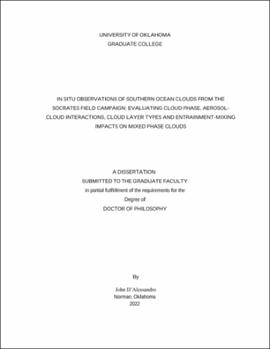| dc.description.abstract | Low level clouds are ubiquitous over the Southern Ocean. However, climate and weather models fail to accurately simulate their radiative impact. This has been attributed in part to the inadequate representation of cloud phase distributions. Using in situ airborne observations acquired during the Southern Ocean Clouds, Radiation, Aerosol Transport Experimental Study (SOCRATES) campaign, this dissertation classifies cloud samples with horizontal spatial resolutions ranging from 120‒150 m as either liquid, ice or mixed phase (i.e., liquid and ice particles in the same volume). Cloud phase is determined using a combination of data from the in situ cloud probes and a supervised machine learning algorithm, which determines phase based on particle imagery. An abundance of liquid phase samples is observed over the region (70%) at temperatures from -20° to 0°C. The prevalence of supercooled liquid abruptly decreases to single digit percentages at temperatures less than -20°C. There is also a notable ice phase presence (10%) at relatively high temperatures (> -5°C).
Ice nucleating particle (INP) and cloud condensation nuclei (CCN) concentrations are compared with relative cloud phase frequencies within and above the boundary layer. A positive correlation is found between INP concentrations and ice-containing cloud phase (i.e., ice and mixed phase) frequencies in select cases. However, many cases do not exhibit significant correlation, suggesting a prevalence of alternative ice initiation/growth processes, such as secondary ice production. CCN concentrations are negatively correlated with ice-containing frequencies above the boundary layer, which may be related to longer lifetimes of supercooled liquid clouds in high CCN environments. A strong negative correlation is also found between CCN and large cloud drop (> 25 μm) number concentrations, suggesting secondary ice production may be inhibited in the presence of high CCN concentrations.
A novel cloud layer classification method is introduced to classify cloud layers into single-layer and multi-layer clouds. Normalized occurrence frequencies of ice-containing phases are greater for multi-layer clouds (0.10‒0.32) compared with single-layer clouds (0.05). Frequencies are greatest for the lowest cloud layers of multi-layer clouds, and then incrementally decrease up to the third highest layer. When classifying multi-layer clouds as the lowest, highest, and middle cloud layers, ice-containing frequencies for the lowest and middle cloud layers are similar. These frequencies are greater than those for the highest layers and single-layer clouds, which are also similar to each other. The tendency of greater ice-containing frequencies within the lowest layers of multi-layer clouds suggests a prominent seeder-feeder mechanism exists over the region.
A novel quantitative measure of phase spatial heterogeneity is introduced and used to show that the mixed (liquid) phase is the most (least) spatially heterogeneous phase from temperatures between 20° and 0°C. Greater spatial heterogeneity is associated with broader vertical velocity distributions, suggesting increased turbulence is directly related to spatial heterogeneity. Distributions of precipitation-size particle (diameter > 50 μm) mass and mean diameter shift towards smaller values with greater heterogeneity. These particles are primarily ice, which are observed in mixed and ice phase samples. This may be due to a relationship between cloud lifetime and spatial heterogeneity, where ice particles grow as a mixed phase cloud glaciates resulting in decreasing spatial heterogeneity.
Differences in microphysical properties between coupled and decoupled environments are examined. No significant differences are observed for relative phase frequencies or the spatial heterogeneity. However, drop number concentrations were approximately doubled in coupled environments compared to decoupled environments.
Entrainment-mixing has been shown to impact drop size distributions in warm clouds, but few studies have considered the impacts on mixed phase clouds. By taking advantage of strong correlations between droplet clustering and entrainment-mixing, a clustering metric is used as a proxy to assess the degree of entrainment-mixing in order to maximize the sample size for a statistical analysis of entrainment-mixing impacts on mixed phase cloud properties. A positive relationship is found between the magnitude of droplet clustering and large ice crystal concentrations (diameters greater than ~300 μm), suggesting entrainment-mixing can enhance the Wegener-Bergeron-Findeisen (WBF) process. Particle size distribution functions averaged over different ranges of liquid (LWC) to total water content (TWC) ratio provide insight into the relation of entrainment-mixing to mixed phase cloud evolution. Mixed phase samples with the greatest large ice crystal concentrations occur for LWC/TWC<0.4 in moderate clustering regions. However, these samples are relatively few, whereas high clustering regions have a greater frequency of samples with LWC/TWC<0.4. This suggests sublimation/vapor sinks associated with entrainment can counteract the enhanced WBF. In high clustering regions, small drop concentrations are relatively constant and large droplets (>30 μm) are preferentially removed as LWC/TWC transitions from 1 to 0, representative of glaciation.
These results should provide key insights towards improving the representation of Southern Ocean clouds in both low and high resolution models, as well as improve our overall understanding of varying Southern Ocean cloud types and mixed phase clouds. | en_US |

